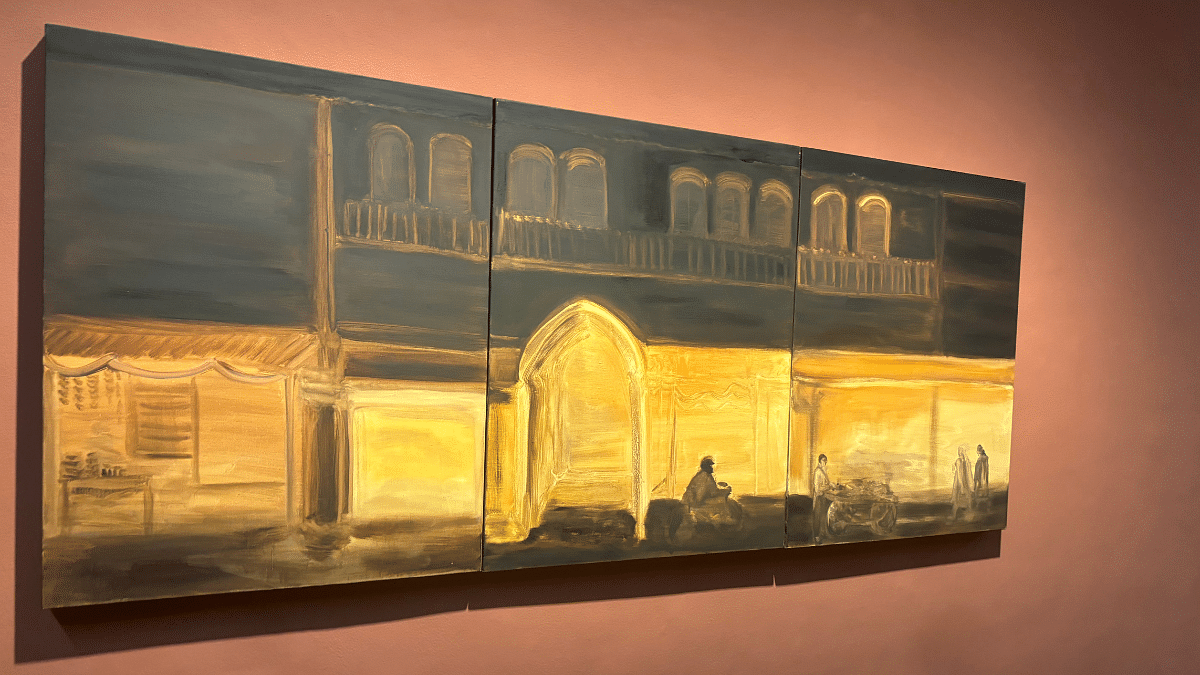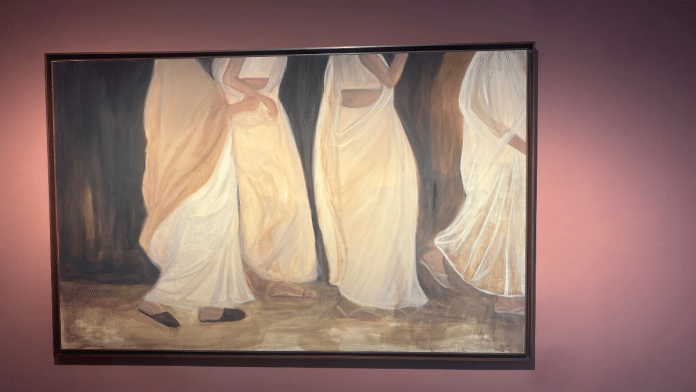New Delhi: Raised in the United States with yearly visits to her ancestral home in Ambala, artist Joya Mukherjee Logue’s exhibition named ‘Those who walk before me’ is an ode to her childhood exploration of identity and culture.
As an Indian-American, her annual gaze at Ambala from Ohio consisted of a fluid sepia-toned tapestry of women in saris, night bazaars, and parties at the ancestral home from five generations ago.
Her first solo show opened this week at the contemporary space of Vadehra Art Gallery in Defence Colony. The exhibition consists of around 30 oil and watercolour paintings. Following the movement of the army cantonment to Ambala in 1845, her great-great-grandfather built this home named Rajovilla and set up his homoeopathy practice. Mukherjee, whose father emigrated to Ohio, US, had her first visit as a baby in 1977.
“None of the paintings is direct replication of any person, image or event, but rather a collaboration between my mind and what I see in India,” Mukherjee said, explaining the interplay of memory and imagination in her art. A tribute to her father, one oil painting is an imagined version of him as a child. It features a small boy in long Bermuda shorts, standing on an old cane chair and holding roses. She describes this as an ode to her father’s love for gardening. “He knows the proper Latin name for all plants, and till date, always knows exactly when my roses need trimming.” she remarked.
She fluidly processes her memory by ensuring that there isn’t much detail or specificity in the form of facial features, markings, clothing patterns to any of her paintings. They feature people gathered in different settings and faceless silhouettes in different rooms and outdoor areas. She emphasises her desire to capture “a moment that could be any time or any day, and in that sense could be timeless”.

Many pieces feature the perspective of a child. One such piece, placed centrally in the gallery, is a moving image of several women clad in saris, their feet shuffling around. The perspective is a look up at the women. It’s almost as if she could hear the “sound of the rustle of the sari fabric and bangles” as the women passed her by.
In fact, she explores the sari and the female form in several artworks. She said she wears the saris that have been passed down two generations of women in her family. With each sari, there is a story, a memory.
Also read: How do postal stamps show adivasis? The same way the British did
The art of remembering
Most of her work depicts women. She attributes it to growing up in a very strong matriarchal family where all the women outlived the men and the influence it has had on her identity growing up. Her artwork is also a medium for her children to experience what she grew up seeing and feeling connected to. “I worry that things will change. Like in the bazaar, things have already changed so much physically, but it still holds the same energy. But if these changes just keep happening, you wonder how things will turn out. I paint also to preserve my memories and my experiences,” she said. Her fears are also borne out of recent legal cases her ancestral house has been involved in as well as other developmental changes around Ambala, especially during the pandemic, which are changing the structure of how she remembers the town.
Growing up around her mother’s family in Ohio and attending a Catholic school, Mukherjee’s upbringing was in predominantly white spaces. She noted always feeling like she looked different from everyone around her. Each time she came to India, she instantly felt ‘at home’ and drawn to her cultural heritage. She wanted her artwork to be representative of those who looked like her too.
All the paintings have a deliberate use of earthen tones. Colours like faded brick, terracotta, layered orange, and oxide red are visible throughout the collection. The base of each painting, regardless of the focus subject, is one of these colours. She said she saw India through these earthen tones. “People often describe my work as dreamy and nostalgic, but for me, this is what is most real.”
Vadehra Art Gallery is in the process of collecting the works of South Asian artists abroad.
“In the last year, we [have] been expanding our programme to include South Indian diasporic artists — Zaam Arif who is a Pakistani artist based in the US; Ashfika Rahman who lives between Dhaka and Amsterdam; and Joya Mukerjee Logue who is Indian-American, based in Ohio,” said director Parul Vadehra. “Joya’s practice, apart from being beautiful visually, speaks deeply and meaningfully about her ancestral history, and the cultural continuity in contemporary India.”
Previously, Mukherjee has held exhibitions in the US as well as in London. Her artwork has also been featured in the 2023 Bollywood film Gulmohar starring Manoj Bajpayee and Sharmila Tagore. In the future, she hopes to portray her parents’ story through her art.
The exhibition will be on view until 17 September 2024.
(Edited by Humra Laeeq)






